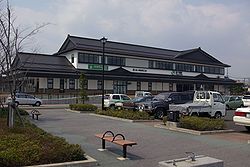Kanegasaki
|
Kanegasaki 金ケ崎町 |
|||
|---|---|---|---|
| Town | |||

JR Kanegasaki Station
|
|||
|
|||
 Location of Kanegasaki in Iwate Prefecture |
|||
| Coordinates: 39°11′44.16″N 141°06′58.80″E / 39.1956000°N 141.1163333°ECoordinates: 39°11′44.16″N 141°06′58.80″E / 39.1956000°N 141.1163333°E | |||
| Country | Japan | ||
| Region | Tōhoku | ||
| Prefecture | Iwate | ||
| District | Isawa | ||
| Area | |||
| • Total | 179.76 km2 (69.41 sq mi) | ||
| Population (September 2015) | |||
| • Total | 15,965 | ||
| • Density | 88.8/km2 (230/sq mi) | ||
| Time zone | Japan Standard Time (UTC+9) | ||
| City symbols | |||
| • Tree | Cryptomeria | ||
| • Flower | Satsuki azalea | ||
| • Bird | Copper pheasant | ||
| Phone number | 0197-42-2111 | ||
| Address | 22-1 Nishine-Minami-chō, Kanegasaki-chō, Isawa-gun, Iwate-ken 029-4592 | ||
| Website | Official website | ||
Kanegasaki (金ケ崎町? Kanegasaki-chō) is a town located in Isawa District, Iwate Prefecture, in the Tohoku region of northern Japan. As of September 2015, the town had an estimated population of 16,122 and a population density of 88.8 persons per km2. The total area was 179.76 square kilometres (69.41 sq mi).
Kanegasaki is located at the confluence of the Kitakami and Isawa rivers and is bordered to the north by Kitakami-shi, to the east and south by Ōshū-shi. In the mountains to the west, there is a large reservoir known as Sengaishi that is dammed and used for irrigating the rice paddies in the plain below. Kanegasaki is characterized by a variety of geographical features, including mountains and wide expanses of rice paddies to the west and a small merchant district and neighboring residential areas to the east. On the border of Kanegasaki and Esashi two neighborhoods (Jōnai and Suwa-kōji) were once the location of a castle that sat at the border of the Nambu and Date domains, and several examples of gardens and houses from the Edo period that were residences of samurai prior to the Meiji Restoration of 1868 remain.
The area of present-day Kanegasaki was part of ancient Mutsu Province, and has been settled since at least the Jomon period by the Emishi people. During the later portion of the Heian period, the area was ruled by the Northern Fujiwara. During the Sengoku period, the area was contested by various samurai clans before coming under the control of the Date clan of Sendai Domain during the Edo period, under the Tokugawa shogunate.
...
Wikipedia



